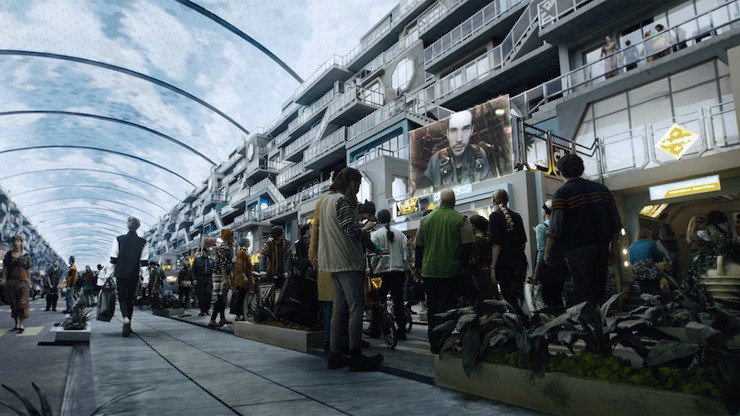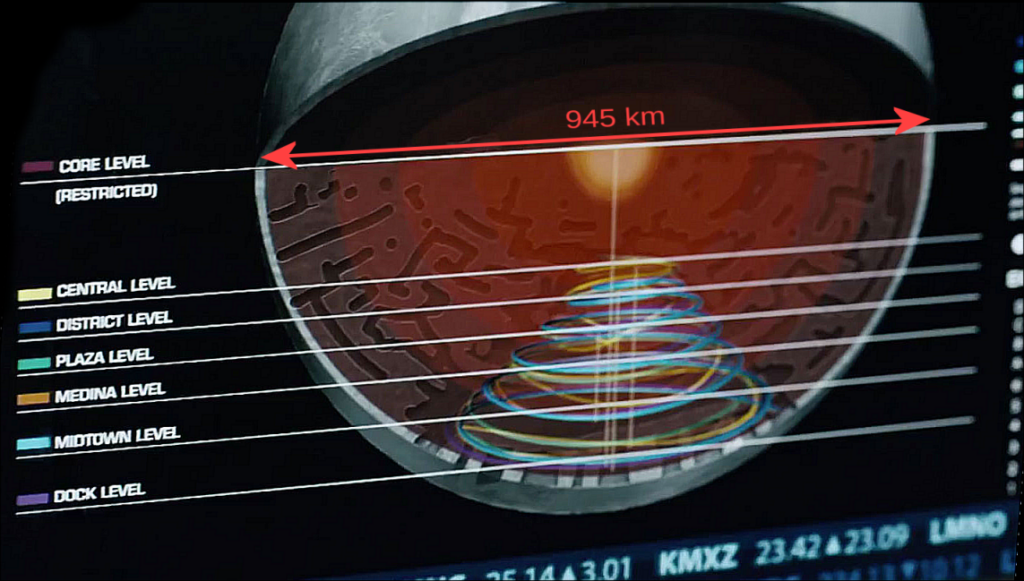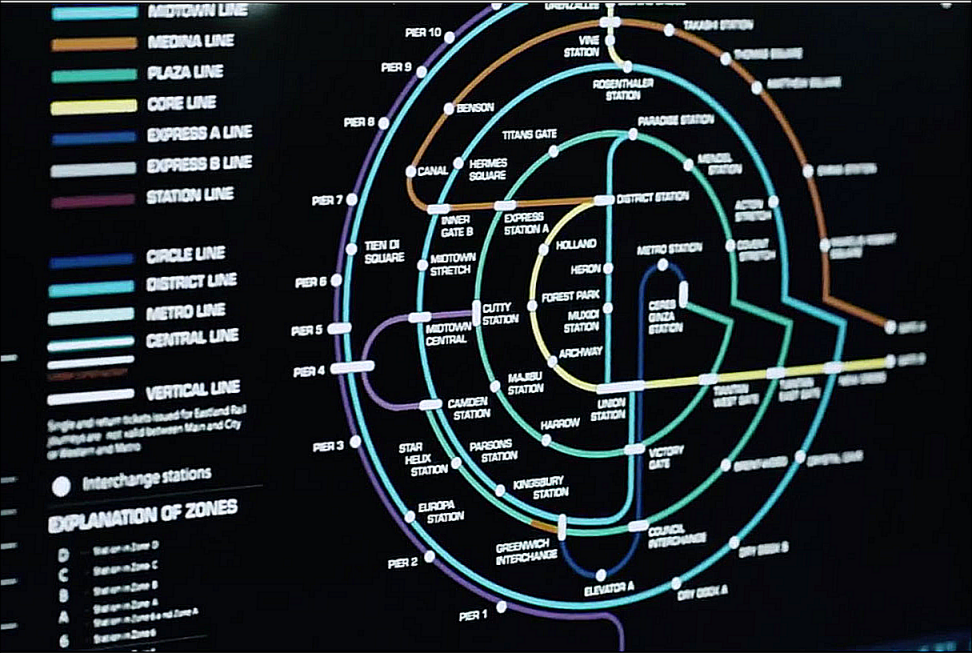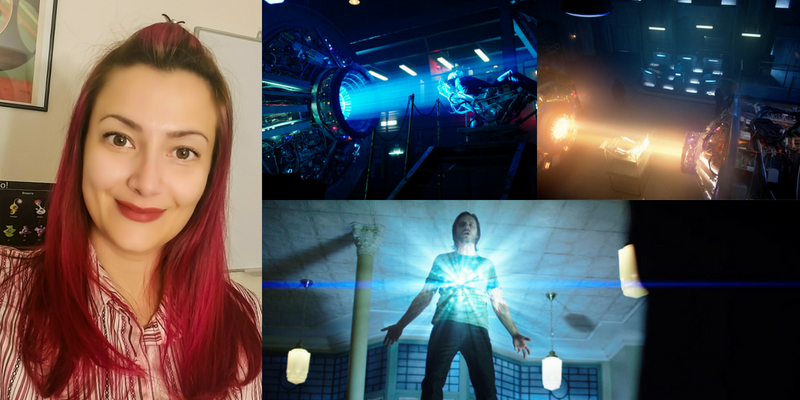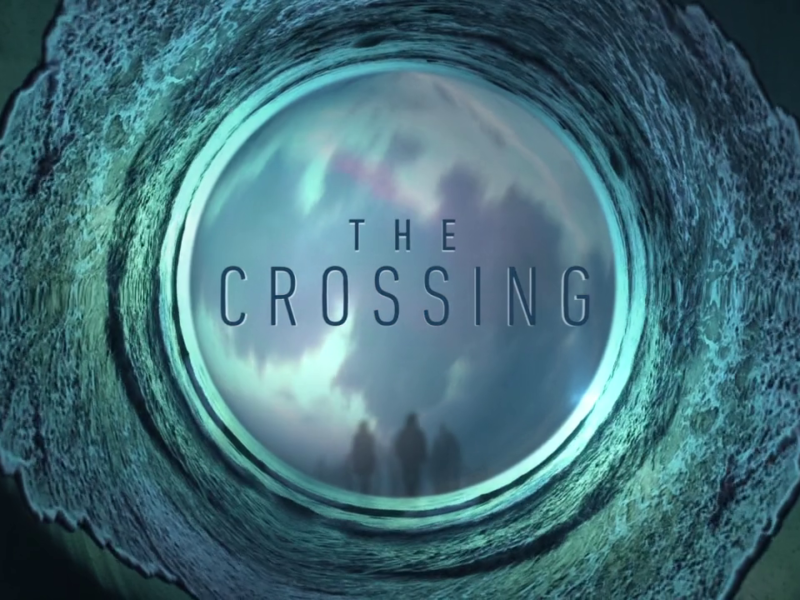The Ceres Station in the series The Expanse is built from the dwarf planet Ceres. This planetoid converted to space station is home to some six million residents and has anywhere between 800 to 1,000 ships docked on any given day. The dwarf planet has an average diameter of 946 kilometers (588 miles) with a surface gravity that is less than three-hundredths that of Earth's (0.027g) making it unsuitable for human habitation. To make things more livable, the engineers of Tycho Manufacturing have artificially spun the asteroid so that its surface gravity is three-tenths of Earth's (0.3g). This is a little lower than Mars which has a gravity that is 0.378 that of Earth's. Some interesting consequences arise when we look at the physics of a spun-up Ceres. The mantle is now under considerable geological stress and the slightest disturbance could make the whole thing fall apart.
The Physics of Ceres and the Ceres Space Station

Gunnery Sergeant Roberta "Bobbie" W. Draper (Frankie Adams) sees the oceans on Earth for the first time (Credit: SyFy)
As we have explored in a previous article, the dwarf planet is roughly spherical and covered with a 100-kilometer layer of ice. Strip mining all this ice and sending it to Earth has angered both Martians and Belters. There was enough water on Ceres equivalent to the Indian Ocean. Had any of this water been sent to Mars, the planet could have the oceans every Martian dreams about.
Mining and sending Ceres' ice to Earth is a remarkable accomplishment for the engineers of Tycho Manufacturing. Miners must shoot cargo into space so that it escapes Ceres' gravity well before it can be sent on its way to Earth. Fortunately, this is aided by Ceres' huge artificial spin. The space station is spinning so quickly that it has changed down into up, and a very strong up at that. This leads to an interesting design - airlocks are located on the surface of the planetoid. Sending cargo into space literally means dropping it and letting it fall.
Ceres Data
The Length of a Day on Ceres
A day on Ceres lasts about 9.07 hours, but a spun-up Ceres Station is more space station than actual planetoid. Its design follows the principles of the hypothetical rotating wheel space station where its rotation creates artificial gravity through centripetal acceleration. Spinning up to 0.3g means a shorter day for Ceres Station with a day lasting 42.1 minutes. The International Space Station orbits the Earth every 90 minutes and astronauts see sixteen sunrises and sunsets in one day. This must be a remarkable sight for the space station's inhabitants as they can see about 34 sunrises and sunsets in the course of one Earth day.
But things don't quite stop there. Ceres is a mining colony and the asteroid itself is being strip-mined away, becoming smaller as it does so. The distance around the asteroid's equator is smaller and so too is the length of the day as it spins around its axis. A strip-mined asteroid's day is now 21.6 minutes. You would think this means things are now going really fast on the planetoid's surface but you would be wrong. The planet has slowed down by more than 50%.
Ceres' Surface Speed
The dwarf planet Ceres surface speed at its equator is approximately 327.7 km/h. This may seem fast but Earth's surface speed at the equator is much faster at 1670 km/h but in Ceres' defense, it is a dwarf planet.
Creating artificial gravity on Ceres Station has also increased its surface speed by a considerable amount. The surface speed along the equator of an unmined Ceres Station is moving at the neckbreaking speed of 1,179.3 m/s (4245.5 km/h). This is thirteen times faster than what it was originally!
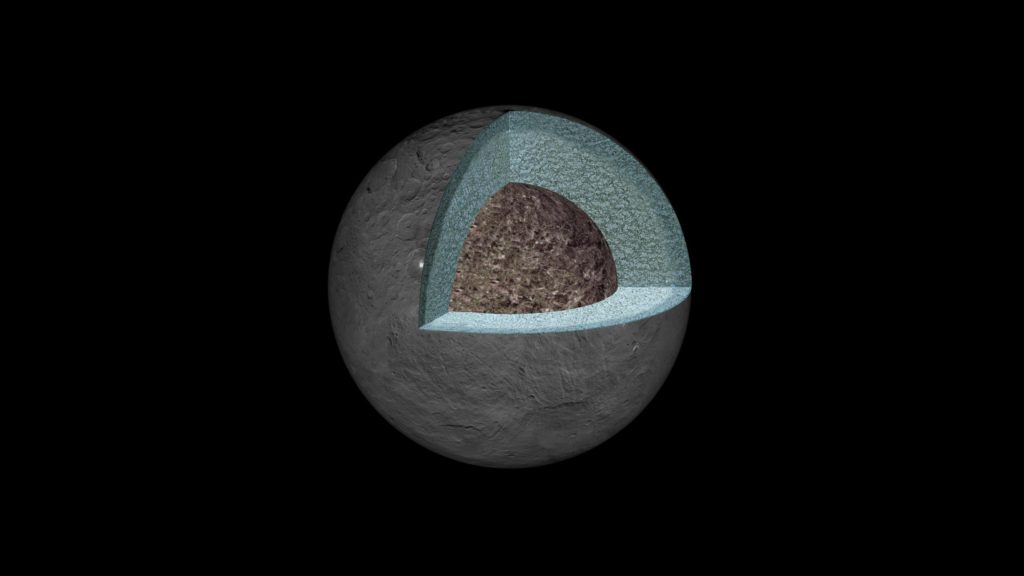
This artist's concept shows a diagram of how the inside of Ceres could be structured, based on data about the dwarf planet's gravity field from NASA's Dawn mission. (Credit: NASA)
Strip mining has again changed the space station in considerable ways. Its circumference at its equator is now smaller which means that the surface speed needed to keep artificial gravity at 0.3g is also reduced. The surface speed at the equator is around 606.2 m/s (2182.4 km/h).
Ceres' Escape Velocity and Launching into Space
The escape velocity is the minimum speed an object needs to escape a planetary body and never return without the need for thrust. In the case of Earth, this is 11.2 km/s or 40,320 km/h. Ceres has an escape velocity of 514 m/s or 1,850 km/h. A planetoid's escape velocity depends on its mass and size so a spun-up Ceres Station's escape velocity is not going to change. The massive strip mining operation will change the planetoid's mass and size, reducing the diameter to 250 km leaving the station with an escape velocity of 166 m/s or 597.6 km/h.
This means in all possible scenarios, a spun-up Ceres's surface speed in faster than its escape velocity. Anthony Barker, a physicists at Purdue University, explains to Science vs. Hollywood how throwing someone out an airlock on most locations on Ceres would not leave a body lying around for others to find; a body eventually escapes the parent and goes into solar orbit.
But if someone truly wanted to commit the perfect crime and dispose of a body so no one could find it, Barker explains there is a ten minute period every 21 minutes when a body flung out the airlock would be cloaked in the shadow of Ceres' night, making it very difficult for someone looking out the window to notice. The best time to do this would be just after sunset where the body would travel along Ceres' shadow for thousands of miles.
But no crime is truly perfect - what goes up must come down. The projectile would have an orbit that eventually crosses Ceres' - it will come back and hit Ceres tens of millions of years later. Let's say that our nefarious murderer is unable to launch his unfortunate victim out of an airlock at the equator and had to do it at one of the poles, even if a body does not have enough energy to escape Ceres, when it comes back down, it will get a huge kick as it collides with the ground. This sends it blasting away from the surface at escape velocity while blasting a small crater at impact.
Ceres' Angular Momentum
One of the more interesting physical properties is the planetoid's angular momentum. The angular momentum is the rotational analog to linear momentum, the size of which gives us and idea how difficult it is to slow or stop a body's rotation.
Ceres' angular momentum is 1.26 × 1028 kg m2/s. Spinning the space station up to 0.3g increases its angular momentum to where becomes 2.11 × 1029 kg m2/s. This is a little over thirteen times its original value indicating the engineers of Tycho manufacturing went to considerable effort to spin up the planetoid. This is even more remarkable considering the time they were able to do it.
A skater performing the traditional "scratch-spin" starts with the arms outward but as she pulls her arms in, her rotation increases. We expect this because angular momentum is a conserved quantity - the size remains the same over time. Calculations show this is not happening. Ceres Station's angular momentum is being lost and it has to go somewhere.
Unlike the skater whose mass stays the same during the scratch-spin, Ceres is constantly losing mass to mining - most of its angular momentum ends up being shed by launches of its ice and rock from the equator. Ceres angular momentum after mining is 7.88 × 1026 kg m2/s. This final angular momentum is twenty times lower than what it was before Ceres was spun-up indicating how much of Ceres' mass has been shipped away to Earth.
Ceres Station Airlocks
This explains why the space station has airlocks on the planetoid's surface - they are launching ports where ships can literally be dropped into space. A pilot can choose the latitude to launch from which can give a ship an initial kick up to 0.6 km/s, more than enough to escape Ceres' gravity well without the use of thrusters. This, of course, has the disadvantage of robbing Ceres of its angular momentum, so there are limits on how large a ship the station can launch into space.
This means that while the equator is the best place to launch ships, the pole is also the best place to dock. Barker explains there is a 1 km diameter patch around the poles where the centripetal acceleration is negligible to gravity. The poles are the only possible location for vertical docking ports as seen on the TV show, while everywhere has horizontal docking ports, with down being out, to deftly catch ships as they fly by.
All this means that gravity "acts" strange on Ceres Station, something we see first hand as "Joe" Miller (Tom Jane) pours a drink in The Big Empty - the liquid curves its way into the glass. This is a combination of several factors. As we have seen before, depending on where you are in the space station, "up" might not be where you think it is in relation to the room. The liquid also curves because of the Coriolis effect, the fictitious force that is responsible for making hurricanes travel along a curved path.
Why doesn't Ceres fly Apart?
The big question is why doesn't Ceres fly apart at these speeds. The shape of a planetary object is determined by the sum of all the forces acting on each point of the body - the gravitational force, the rotational force, the rigidity of the planet's material, and tidal interactions with other planetary objects. If a body is small, as is the case for an asteroid or meteorite, rigidity gets the upper hand and the body can have very strange shapes - this is the case for Eros which has a peanut shape. If the mass is large, gravity becomes the dominant force with rigidity becoming negligible. The planetary body is close to a sphere.
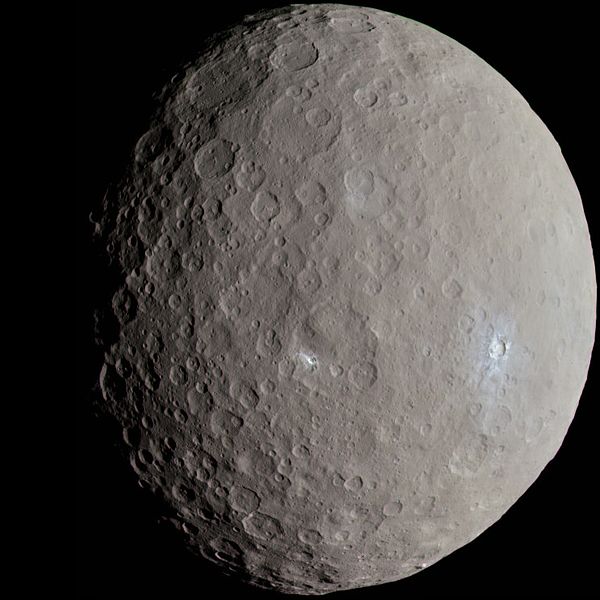
True-color image of Ceres taken by Dawn spacecraft in May 2015. (Image Credit: NASA / JPL-Caltech / UCLA / MPS / DLR / IDA / Justin Cowart)
Ceres is a dwarf planet and has enough gravity to overcome its own rigidity and assume hydrostatic equilibrium. If Ceres were not rotating, it would form a perfect sphere. With rotation, it becomes a flattened sphere. But Ceres is spinning so fast it has changed down into up. As Dr. Barker explains, "Every rock on Ceres is like the underside of a cliff overhang with no ground supporting the cliff. Only the tensile strength of the rock can hold the planetoid together - the core of the dwarf planet now has a negative pressure of 300 Megapascals (43511.3 pounds per square inch), which is more tension than natural rock can support." James S. A. Corey writes, "Spinning it [Ceres] up to 0.3 g had taken the best minds at Tycho Manufacturing half a generation", presumably the engineering brilliance of that was figuring out how to build synthetic supports to hold the planetoid together."
The Future of Ceres Station
This puts Ceres in a precarious situation. The planetoid is geologically unstable and will slowly fly apart as surface rock comes loose. Things are so bad, a major explosion could make the entire thing fly apart all at once. Ceres is more than a space station, it is their home and only city. They would do well the worry about the future and stability of Ceres. It is easy to see a day when the dwarf planet no longer exists at all - either from flying apart or mining carries away the remaining mass.
Also published on Medium.

